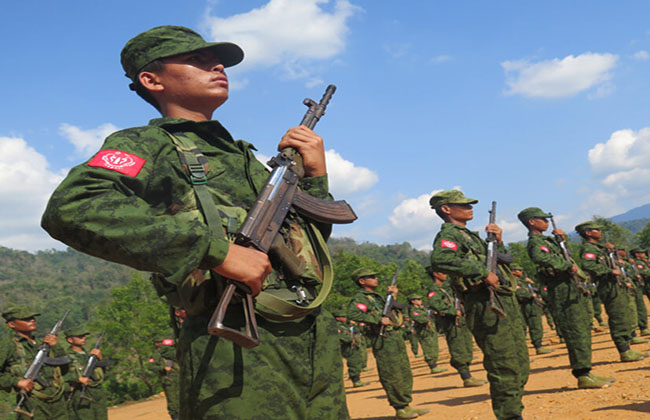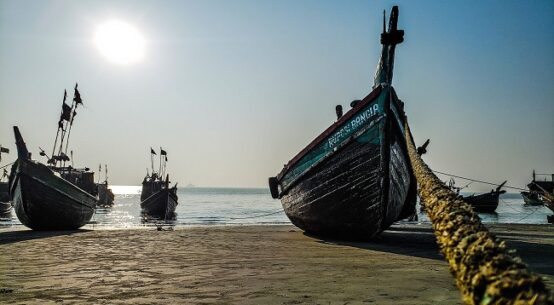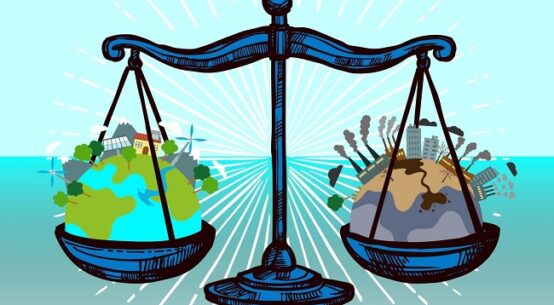
While heavy fighting has been raging in Myanmar’s ethnic minority areas, and clashes between local resistance groups called People’s Defense Forces and the Myanmar military have occurred almost daily since last year’s coup, Rakhine State in the west of the country has been largely peaceful.
The Arakan Army (AA), the state’s main rebel force, entered into an informal ceasefire agreement with the Myanmar military several months before the February 1 coup and, so far, the truce seems to be holding. But much to the military’s chagrin the AA, or more specifically its political wing, the United League of Arakan (ULA), has used the peace to build up a separate administration in the state with its own judicial bodies, revenue department, public security branches and other governmental institutions.
The military, on the other hand, is stretched on many fronts across Myanmar and can hardly afford to send the number of troops that would be required to re-establish control over Rakhine State. But it is a fragile ceasefire agreement and it is still a question of who would attack whom first and when.
If the generals decide to open a new front in Rakhine State, they would be up against a formidable adversary. From humble beginnings in 2009, the AA has grown into one of Myanmar’s most potent rebel armies.
It was originally formed by a group of youngish nationalists led by Twan Mrat Naing, then only 31, and recruits from the many ethnic Rakhine who work in the Hpakant jade mines in Kachin State. Initially trained by the Kachin Independence Army, they first saw combat in 2012 when the military launched a massive offensive against rebel bases along the Chinese border.
Three years later, AA troops fought alongside soldiers from the Palaung militia, the Ta’ang National Liberation Army, and the Myanmar National Democratic Alliance Army in the Kokang area of Shan State in 2015. From then on, the AA grew rapidly and moved most of its operations to its home state of Rakhine. Thousands of young male as well as female nationalists flocked to join the AA, and bitter battles were fought with the Myanmar military.
Twan Mrat Naing, now 43 and a Major-General, was born in the Rakhine capital Sittwe and studied law at university but left without getting a degree. In a recent interview with this correspondent, he emphasized the pride that many Rakhine feel for their state and its long and often turbulent history.
Rakhine, formerly known as Arakan, was an independent Buddhist kingdom until it was invaded by the Burmese in late 1784 and then, the following year, annexed into the realm ruled by King Bodawpaya of the Konbaung Dynasty.
Resistance against the occupation continued until the first Anglo-Burmese War in 1824-1826. The Arakan region, along with Tenasserim [now part of Tanintharyi Region] in the southeast, became British possessions.
Peace prevailed until World War II, when Myanmar was occupied by the Japanese — and that caused serious divisions within Arakan. Most Buddhist Arakanese sided with the Burma Independence Army — and hence the Japanese — while large segments of the Muslim population in northern Arakan remained loyal to Britain, the colonial power. Immense atrocities were committed by both sides, and those wounds have never completely healed.
The departure of the British in 1948 led to a virtual civil war in Arakan. Muslim mujaheed guerrillas — they were then not yet called Rohingya — established bases along the border with East Pakistan and, originally wanted to join independent Pakistan. The Communist Party (Red Flag) (CP[RF]), led by Bonbauk, or “bomb thrower” Tha Gyaw, also battled government forces and so did U Sein Da, a former monk known as “the King of Arakan.”
The main Communist Party of Burma (CPB) also established strongholds in Arakan, while breakaway militants from CP[RF] formed a separate Communist Party of Arakan (CPA) and wanted to establish their own people’s republic.
Over the years, most of the insurgencies fizzled out. In 1961, the last 500 mujaheeds surrendered as the then U Nu government agreed to set up an autonomous area known as the Mayu Frontier Administration encompassing Maungdaw, Buthidaung and western Rathedaung townships, where Muslims are in a clear majority.
General Ne Win’s coup d’etat in 1962 put an end to those efforts and some Muslims formed new groups, notably the Rohingya Independence Force which in 1975 became the Rohingya Patriotic Front. But those groups were small and their activities limited to publishing leaflets and newsletters from their offices in Chittagong, Bangladesh.
“Bonbauk” Tha Gyaw had surrendered in 1955 and U Sein Da in 1958. The main CP(RF) leader Thakin Soe was captured in 1970 at his Than Chaung camp near the Arakan Yoma mountains.
The CPB’s local leader Kyaw Mya left Arakan in 1979 and went to Bangladesh, where the Chinese embassy helped him to continue on to China and then down to the party’s main headquarters at Panghsang in the Wa Hills in Shan State. His successor as local leader of the CPB, Ye Tun, surrendered during a general amnesty in 1980, and so did CPA leader Kyaw Zan Rhee.
On the Thai border, a small group called the Arakan Liberation Organization and Army had been formed in 1972, but it had only a handful of soldiers who were based at Kawmoorah, a Karen National Union stronghold north of Mae Sot.
Peace seemed to prevail in Arakan, which was renamed Rakhine State in 1974, but then came the 1988 nationwide democracy uprising. Some of the old fighters, among them Kyaw Zan Rhee and “Bonbauk” Tha Gyaw, resurfaced, took part in the pro-democracy movement and formed an overground, legal party called the Arakan People’s United Organization.
Another, and stronger, legal political party called the Arakan League for Democracy (ALD) also emerged, and was led by Dr U Saw Mra Aung and the historian U Oo Tha Tun. The ALD took part in the 1990 general election but its MPs elect, like all the other elected politicians, were not allowed to take up their seats in Yangon.
The elected National Assembly was never convened and instead a mainly military-appointed National Convention was convened to draft a new constitution. U Oo Tha Tun died in prison in 1991 and, in 1992, the ALD was banned.
Against that backdrop — and given Arakan/Rakhine’s long history of resistance — it is hardly surprising that the new AA and the ULA have grown so fast and become what they are today. Or, as Myanmar specialist Martin Smith wrote in Arakan (Rakhine State): A Land in Conflict on Myanmar’s Western Frontier, which was published by the Netherlands-based Transnational Institute in December 2019: “Among [the many Rakhine groups] only the ULA could be considered as new.
But, as its supporters point out, the ULA includes members from other organizations and is the latest in a long line of armed Rakhine movements that date back to independence in 1948. As such, the ULA has quickly become the most powerful force in Rakhine nationalism in many decades.”
But the armed wing, the AA, is also facing formidable challenges. The most obvious one is logistical: how to get guns and ammunition from rebel-held areas in Kachin and Shan State — where the main source of military supplies are — to Rakhine? During the fighting before the ceasefire agreement was struck, the AA showed that it had remarkable firepower and the Myanmar military suffered heavy casualties.
But if fighting resumes, how can the AA’s troops be resupplied? The other issue would be how to relate to the state’s Muslim population. In recent years, an extremely militant group called the Arakan Rohingya Salvation Army (ARSA) has emerged. It launched several attacks on military and police outposts in 2016 and 2017 which, in turn, led to a massive counteroffensive and the flight of hundreds of thousands of Rohingya to Bangladesh.
ARSA should not be considered an indigenous group — it was formed by Ataullah abu Ammar Jununi, a second-generation Rohingya. He was born in Karachi, Pakistan, and grew up in Saudi-Arabia, where he was groomed by Islamic fundamentalists.
Ataullah has unleashed his fury even on what are supposed to be his own countrymen, among them Mohib Ullah, a Rohingya moderate and human rights activist, who was killed by ARSA in a refugee camp in Bangladesh on September 29, 2021.
In a recent video, a visibly angry and agitated Ataullah exhorts his followers to “burn down” the dwellings of Rakhine Buddhists and “strike hard” against them.
It may be easy for the AA to distance itself from ARSA, but the Rohingya question is bound to create controversies. While the AA and other Rakhine nationalists accept the fact that Muslims have been living in the area for centuries, and that many more settled in Arakan during the colonial era, they argue that most Rakhine consider the very name ‘Rohingya’ offensive and refuse to use it.
According to their line of argument, it gives the impression that the Muslims are not a religious community but a distinct ethnic group, and, as some of the Rohingya claim, that they are the original inhabitants of the land.
Rather offensively, nearly all political movements among the Rohingya also have a map of the entire Rakhine State in their emblems. Rakhine nationalists also argue that the name Rohingya was not used by anyone until the 1950s.
Those who argue that there is separate Rohingya identity based in history usually quote a 1799 study by Scottish physician and geographer Francis Buchanan-Hamilton, who never went to Arakan but met some Muslims in the then capital Amarapura.
He mentions that they referred to themselves as “Rooinga, or natives of Arakan” and then said little more. But, as Martin Smith points out: “After annexation [in 1826], the British do not appear to have used this name again. Muslims in Arakan were instead referred to by such terms as Arakanese Mohammedan, Bengali Muslim, Chittagonian, Kaman and Zerbadi…[and] it would be difficult to imagine a situation in modern-day Europe where discussions of citizenship or identity become based around the writings of an Asian traveler two centuries ago.”
Be that as it may, but there are few questions in Myanmar today which are more than contested — and often heated — than disputes over the origin of the name Rohingya, and who and what they are. Internationally, the name Rohingya and their identity as such is almost universally accepted. But it’s an entirely different story in Myanmar, and then not only among the Rakhine. On this issue, most Burmans would be on the same side as the Rakhine nationalists.
This year and next may reveal what the future holds for the new nationalist movement in Rakhine State. A lot depends on what happens in the rest of the country.
On the one hand, the junta has not managed to consolidate its grip on the country and its coup last year may go down in history as the most unsuccessful attempt to seize power in modern Asian history. That works to the advantage of the ULA and its parallel administration as well as the resistance elsewhere in Myanmar.
But, on the other hand, future developments depend on the extent to which the country’s abundance of resistance forces can coordinate their movements — and despite some alliances being forged — there is so far little evidence of that happening.
Bertil Lintner is an award-winning journalist and author who specializes in Burma


